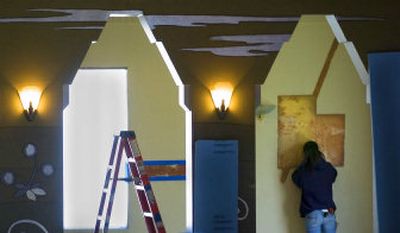Fox is an art-deco archetype

A New York consultant who has helped restore more than 150 historic theaters in the United States said on Tuesday that the 1931 Fox Theater in Spokane ranks among the great movie palaces of the era and, like the others, is filled with exquisite, irreplaceable period design.
“It’s pure art deco,” said Jeffrey Greene, an expert in the murals, light fixtures and other decorative furnishings found in old theaters.
As president of EverGreene Painting Studios Inc., Greene has been hired as part of the $22 million restoration of the Fox in downtown Spokane.
When the work is completed in late 2007, the 1,725-seat theater is expected to become the new home for the Spokane Symphony and a new venue for regional performing groups.
Greene said the project, if it follows the pattern of theater renovations in other cities, will bring additional economic vitality to downtown Spokane.
“It’s a jewel,” Greene said as he surveyed the lobby and compared it to Radio City Music Hall in New York, which he helped to restore.
Movie theaters such as the Fox were erected at a frenetic pace in the late 1920s and early ‘30s – as many as 400 to 500 a year as the popularity of film swept the country, he said.
William Fox of Fox West Coast Studios, later to become 20th Century Fox, presided over construction of nearly 280 Fox theaters around the country, using teams of designers and artisans in each city. Fox theaters in Atlanta, St. Louis and Stockton, Calif., are among those that have been restored.
The Fox motif in Spokane is derived from a Hollywood interpretation of art deco, a style that emerged from the modernist and art noveau movements in Europe in the late 1800s. In the U.S., it was distilled into a more streamlined form, celebrating the convenience and practicality of machines, as well as the style and tempo of jazz.
“It really came to a head in America,” Greene said.
Dutch-born designer Anthony Heinsbergen, who migrated to Los Angeles in 1906, combined his eye for the flowing classical forms of art noveau with the rectilinear geometry commonly associated with art deco in the United States to achieve his creation for Spokane, Greene said.
“This would have been the full flowering of art deco. This is pure deco. This is the zenith of deco right here.
“Even though this is unique,” he said, movie houses were going up so fast that the process became “almost formulaic to them.”
The challenge for Greene is to piece together a true picture of what the theater looked like on opening day. He and an assistant are in Spokane this week studying original black-and- white photos, paint patterns and paint compositions.
“If you look at the old black- and-white photos, it was very exuberant,” Greene said. “It was beautiful.”
In the lobby, some of the original mural work was covered with a newer coat of red paint. They are removing a portion of the newer paint to reveal the mural pattern underneath. Greene said he will likely recommend a re-creation of the lobby murals rather than a painstaking restoration. Part of his investigation involves studying paint chips under a microscope to determine their composition.
Carpet, drapery, upholstery and curtains all take their cues from the mural colors. Heinsbergen relied heavily on metallic finishes from light fixtures to aluminum seat row ends. “They all fit together as a piece,” Greene said.
Six years ago, the Fox was threatened with demolition. It was saved when 900 donors contributed $1.1 million to a Save the Fox fund. The state Legislature later appropriated $6 million for restoration under the direction of The Fox Theater organization, a nonprofit affiliated with the Spokane Symphony. Another $9 million has been raised through other public and private sources.
Residents of Spokane won’t regret restoring it, Greene said. “It’s part of the fabric of the city,” he said. “Take it away; Spokane is that much less for it. Preserve it; Spokane is that much greater for it.”